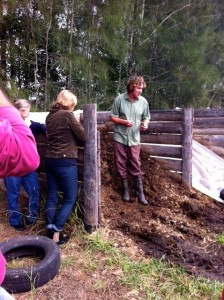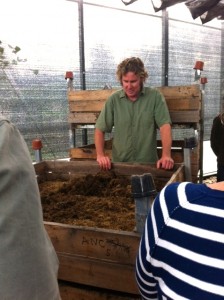At Islands in the Stream, compost worms feed microbes that new gardens need for plant growth. Vermiculturist Lee Fieldhouse has confirmed a deep suspicion I’ve always had, that my gardens were missing something during their early establishment. Some plant families like Rutacea (citrus, murraya) and Acanthacea (mackaya bella, ruellia) seemed especially affected showing persistent chlorosis well into the second year.

Turns out the humble earth worm has a lot more to do with this than I ever knew. It appears their castings and spit are colonised by very specific microbes that contain chemical signatures unlocking nutrient gates to plant root systems. So no worms, no castings/spit, equals no or low microbes, means limited or no nutrient availability to plants.
Designers necessarily import rather large quantities of “soil-less” component parts (sand, spent mushroom compost, ash, recycled sewerage waste and composted wood chip in one form or another) comprising imported mixes that pass for “dead” top soil, devoid of beneficial soil bacterium and fungus.
This means nutrient is locked up from plants in new gardens, while we wonder why they sometimes fail to thrive despite slow release, organic nitrogen like manures and other goodies used at planting time.
Having used Lee’s odourless, fairly light weight worm processed, microbe enriched paunch with all new planting here at the “Sea-Changer”, I can attest the new garden has been far more robust and pest resistant than usual. The sterile mix I brought in to correct levels and plant in over underlying estuarine silt, is now bulging with worms where there were none and has lost the nasty anaerobic “stink” it had .. Used in another new garden at MacMasters Beach for Tania Wilson to equal effect, I’m now sold, BIGTIME.

Aside from bagged product, Lee also has a liquid form available soon, that I used at planting to bring root systems into instant contact with nutrient and as a foliar drench without a single loss to “plant shock” during heat wave conditions. This combination resulted in far less time for plants to “bite” into top soil at planting.
Islands in The Stream – Lee Fieldhouse
66 Tea Tree Lane
Mitchells Island NSW 2430
leefieldhouse@rocketmail.com
0429 197 596
